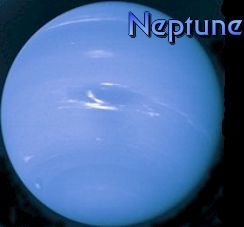

![]()
|
In Roman mythology Neptune was the god of the Sea. He is known as Poseidon in Greek mythology. The planet was probably named after the sea gods because of its deep blue color. |
|
This is the
symbol for Neptune:
|
|
|
|
Neptune's blue color is the result of a gas called "methane" in its atmosphere. Like the other gas planets, Neptune has rapid winds trapped in "bands" of latitude and large storms. Neptune's winds are the fastest in the solar system, reaching 2000 km/hour! |
|
|
|
At the time of Voyager's flyby, Neptune's most outstanding feature was the "Great Dark Spot" in the southern hemisphere. It was about half the size as Jupiter's "Great Red Spot" - about 1 Earth would fit into it. Neptune's winds blew the Great Dark Spot westward at 300 meters/second (700 mph)! |
|
Voyager 2 also saw a smaller dark spot in the southern hemisphere and a small irregular white cloud that zipped around Neptune every 16 hours or so now. This feature is known as "The Scooter." |
|
|
Recently, however, the Hubble Space Telescope (HST) showed that the Great Dark Spot has disappeared! Scientists think that it has either dissipated (like our storms do) or is currently being hidden by Neptune's atmosphere. Also, HST discovered a new dark spot in Neptune's northern hemisphere. This shows that Neptune's atmosphere changes rapidly. |
|
Neptune also has rings. The Voyager 2 spacecraft showed scientists that Neptune indeed has complete rings with bright clumps. Like Uranus and Jupiter, Neptune's rings are very dark and very faint. Scientists still haven't figured out what they are made of yet. |
|
|
|